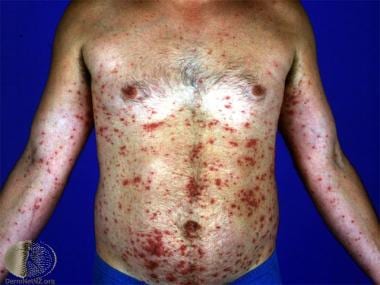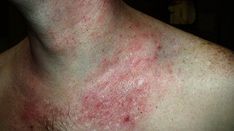Background
Id reaction, or autoeczematization, is a generalized acute cutaneous reaction to a variety of stimuli, including infectious and inflammatory skin conditions. The pruritic rash that characterizes the id reaction, which is considered immunologic in origin, has been referred to as dermatophytid, [1] pediculid, [2] bacterid when associated with a corresponding infectious process, and tuberculid when associated with tuberculosis. [3] Clinical and histopathological manifestations are variable and depend on the etiology of the eruption, and systemic manifestations may occur. [4, 5, 6, 7]
See the image below.
Pathophysiology
While the exact cause of the id reaction is unknown, the following factors are thought to be responsible: (1) abnormal immune recognition of autologous skin antigens, (2) increased stimulation of normal T cells by altered skin constituents, [8, 9] (3) lowering of the irritation threshold, (4) dissemination of infectious antigen with a secondary response, and (5) hematogenous dissemination of cytokines from a primary site. Some cases have been related to medications and intravenous immune globulin. [10] Id reaction has also been noted with BCG therapy. [11]
Etiology of Id Reaction
The etiology of id reactions includes the following:
-
Infections with dermatophytes, pulmonary histoplasmosis, [12] mycobacteria, [13] viruses, [14] bacteria, or parasites (pediculosis) [2]
-
Contact dermatitis, stasis dermatitis, or other eczematous dermatoses [15, 16]
-
Immunization reactions
-
Papulonecrotic tuberculid [17] and some other tuberculids: These are now thought to be true cutaneous forms of tuberculosis and not id reactions because of the identification (by polymerase chain reaction) of Mycobacterium tuberculosis in lesions. However, id reactions have been reported following BCG vaccination. [18]
Epidemiology
Frequency
The exact prevalence of id reaction is not known. Dermatophytid reactions are reported to occur in 4-5% of patients with dermatophyte infections. Id reactions have been reported in up to 37% of patients with stasis dermatitis. Furthermore, an estimated two thirds of patients with contact dermatitis superimposed on stasis dermatitis develop an id reaction.
Race
The condition has no known predilection for any racial or ethnic group.
Sex
The condition has no known predilection for either sex.
Age
Predilections according to age group are unknown but are influenced by the primary cause of the reaction.
Prognosis
Prognosis is good once the inciting etiology has been identified and appropriately treated. Morbidity results from symptoms of the id reaction and the acute onset of the primary eruption.
-
Id reaction (autoeczematization). Courtesy of DermNet New Zealand (http://www.dermnetnz.org/assets/Uploads/dermatitis/a-ecz2.jpg).











